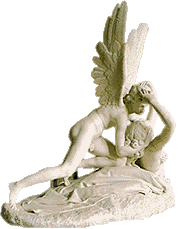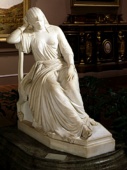

Mottling or streaking that resembles
the veined texture of marble
is called marbling.
Examples of works in marble:
![]()
Greece, Cyclades, about 2500 BCE,
Male Harp Player, marble,
14.1 x 3.7 x 11 inches (35.8 x 9.5 x 28 cm), J. Paul Getty Museum,
Malibu, CA. See Cycladic art.
![]()

Greece, Grave stele of a little girl with doves,
c. 450-440 BCE,
Parian marble relief, height 31 1/2 inches (80.01
cm), Metropolitan Museum of Art, NY.
Italy, Ostia, 2nd century CE after a Greek original of the 5th century BCE, The Hope Athena, marble, height 86 inches (218.4 cm), Los Angeles County Museum of Art.
Laocoön and his Sons, Roman copy of a Hellenistic original from c. 200 BCE, marble, height 1.84 m, Vatican. Trojan priest Laocoön and his two sons are attacked at an altar by giant serpents. Pliny said it was the work of three sculptors from Rhodes, Hagesandros, Polydoros, and Athenodoros. The date of the Laocoön is controversial, some scholars arguing for the late second century BCE, others for c. 50 BCE.
![]()
Roman, after the School of Polykleitos, about
125 CE,
Statue of the Lansdowne Herakles (Hercules),
marble, height 76 3/16 inches
(193.5 cm), J. Paul Getty Museum, Malibu, CA.
Jagaddeva (Indian, active about mid-12th century), The Goddess Sarasvati, 1153, marble, 47 1/4 x 19 3/4 x 11 3/4 inches (120.2 x 50.2 x 29.7 cm), Los Angeles County Museum of Art. Sarasvati is the Jain goddess of knowledge, learning, and music. Also see Hindu art.
Donatello (Italian, 1386-1466), Pazzi Madonna, c. 1422, marble, 74.5 x 69.5 cm, Bodemuseum, Berlin. See a Donatello site [text in Italian].

Francesco Laurana (Italian, c.1430-c.1502),
Bust
of a Lady, c.1470s, marble, height
18 3/4 inches (46.6 cm), width
18 inches (45.8 cm), diameter
of base 9 3/8 inches (23.9
cm), Frick Collection, NY. The Frick has another bust
by Laurana, of Beatrice of Aragon, c. 1470s, also white
marble. See bust.

Andrea del Verrocchio (Italian, 1435-1488), Bust of a Young Woman, marble, height 18 7/8 inches (48 cm), width 19 3/16 inches (48.7 cm), diameter 9 3/8 inches (23.8 cm), Frick Collection, NY.
Michelangelo Buonarroti (Italian, 1475-1564), The Bearded Slave, also known as Atlant, 1527-28, marble, height 8 feet 4 3/4 inches (277 cm), width 2 feet 4 3/4 inches, depth 3 feet 1/2 inch, Galleria dell'Accademia, Florence. This is one of several allegorical figures intended for the tomb of Pope Julius II. See Renaissance.
Michelangelo Buonarroti, The Crossed-Leg Slave, also known as The Prisoner (Il Prigione - ridestantesi), 1530-1536, marble, height 8 feet 10 1/8 inches (267 cm), width 3 feet 1 3/4 inches, depth 2 feet 5 1/2 inches, Galleria dell'Accademia, Florence. This another of the allegorical figures intended for the tomb of Pope Julius II.
Michelangelo Buonarroti, Victory, 1527-28?, marble, height 8 feet 6 3/4 inches (261 cm), width 2 feet 7 1/8 inches, depth 2 feet 9 inches, Palazzo Vecchio, Florence. This another of the allegorical figures intended for the tomb of Pope Julius II.
Michelangelo Buonarroti, Moses, 1508-16 and 1542-45, marble, height 7 feet 8 1/2 inches, width of base at front 3 feet 1 1/2 inches, depth of base 3 feet 3 3/4 inches, San Pietro in Vincoli, Rome. This sculpture is at the base of Pope Julius II's mausoleum. [Detail of the head of Moses. Moses's horns derive from a long tradition in which horns were symbolic of divinity in Near Eastern and Nordic cultures.]

Michelangelo Buonarroti, Crouching Boy, c.1530-1534, marble, height 54 cm, Hermitage Museum,
St. Petersburg, Russia. See nude.

Mughal Emperor Shah Jahan (Indian, reigned
1627-1658), Taj Mahal, 1630-1653, an Islamic tomb in a walled garden built
for Shah Jahan's wife Mumatz Mahal [aka Arjuman Banu Begum],
of bearing masonry
and inlaid marble, in
Agra, India, seat of the Mughal Empire. Sir Banister Fletcher
wrote in A History of Architecture, "The interior
of the building is dimly lit through pierced marble lattices
and contains a virtuoso display of carved marble. Externally
the building gains an ethereal quality from its marble facings,
which respond with extraordinary subtlety to changing light and
weather." See Mughal
dynasty.

Antoine Coysevox (French, 1640-1720), Louis
XV as a Child of Six, 1716, marble, height
23 1/2 inches (59 cm), Frick Collection, NY.

Etienne-Maurice Falconet (French, c. 1716-1791),
Winter, 1771, marble,
height 135 cm, Hermitage
Museum, St. Petersburg, Russia. See drapery
and Rococo.
![]()
Joseph Nollekens (English, 1737-1823), Three Goddesses, [left:] Juno,
1776, marble, height 54
3/4 inches, [center:] Venus, 1773, marble, height
48 13/16 inches (124 cm), [right:] Minerva, 1775, marble,
height 56 11/16 inches,
J. Paul Getty Museum, Malibu, CA. See mythology.
Jean-Antoine Houdon, Voltaire, marble, Hermitage Museum, St. Petersburg, Russia. The plaster version of this sculpture is owned by the Phoenix, Art Museum, AZ.

Antonio Canova (Italian, 1757-1822), Cupid and Psyche, 1796, marble, height
137 cm, Hermitage Museum, St. Petersburg, Russia. This is the
second of two versions. See the first version above.
John Deare (English, 1759-98, active in Italy), Judgment of Jupiter, 1786-87, marble relief, 58 1/4 x 117 1/4 inches (148 x 297.8 cm), Los Angeles County Museum of Art.
Hiram Powers (American, 1805-1873 ), Bust of George Washington, 1850's, marble, Minneapolis Institute of Arts. See bust.

Thomas Crawford (American, 1813-57), Boy Playing Marbles, 1853, marble, Worcester
Art Museum, MA.

William Wetmore Story (American, 1819-95, active in Italy), Cleopatra, 1858, white marble, height 55 inches (139.7 cm), Los Angeles County Museum of Art.


Auguste Rodin (French, 1840-1917), The Kiss [detail], 1901-4, Pentelican marble, 182.2 x 121.9 x 153.0 cm, weight 3180 kg, Tate Gallery,
London.

Daniel
 Chester French (American, 1850-1931),
Abraham Lincoln, 1920, marble, height
19 feet, Washington, DC. This sculpture is at the center of the
Chester French (American, 1850-1931),
Abraham Lincoln, 1920, marble, height
19 feet, Washington, DC. This sculpture is at the center of the
Lincoln Memorial. See memorial.

Constantin Brancusi (French, born Romania,
1876-1957), Bird in Space, 1923, marble, (with base) 56 3/4 x 6 1/2 inches
(144.1 x 16.5 cm), Metropolitan Museum of Art, NY.

Constantin Brancusi, Fish, 1930, gray marble, 21 x 71 x 5
1/2 inches (53.3 x 180.3 x 14 cm), on three-part pedestal
of marble 5 1/8 inches (13 cm) high,
and two limestone cylinders 13 inches (33 cm) high
and 11 inches (27.9 cm) high
x 32 1/8 inches (81.5 cm) diameter
at widest point, Museum of Modern Art, NY.
![]()

Dame Barbara Hepworth (English, 1903-1975),
Three Forms, 1935, Serravezza marble,
20.0 x 53.3 x 34.3 cm, Tate Gallery, London.
Also see acrolith, colossus and colossal, encaustic, incrustation, limestone, mosaic, quarry, sincere, and statue.
https://inform.quest/_art
Copyright © 1996-![]()